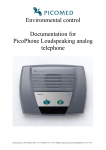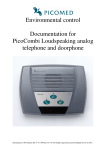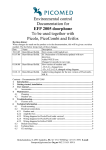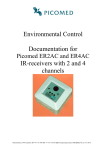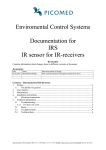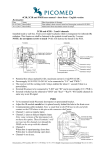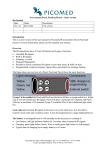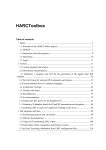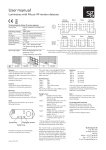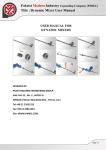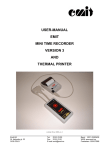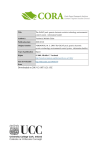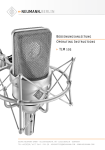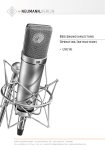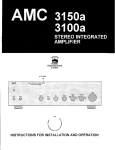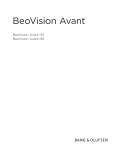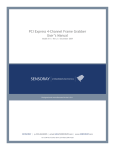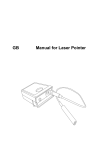Download - Picomed
Transcript
Environmental control Documentation for PicoPhone2 series loudspeaking phones: Picolo2 – door phone PicoPhone2 – analogue telephone PicoCombi2 – door phone and analogue telephone Brokelandsheia, N-4993 Sundebru, Ph + 47 37119950 Fax + 47 37119951 E-mail: [email protected] Org.number 962 211 631 MVA Revision list When changes are made in the documentation it will listed below with date and a short description. Revision list: Date Name 22.11.2012 Bent Sollid. 04.11.2015 Bent Sollid. Description First version. Based on Norwegian version 01.07.2010. Correction of values in prg.table pt 13. Contents – Documentation PicoPhone series 1 2 3 4 5 6 7 Introduction ...................................................................................................................... 4 1.1 PicoPhone products in general ................................................................................... 4 Getting started .................................................................................................................. 4 User manual – Quick guides ............................................................................................ 5 User manual – detailed .................................................................................................... 9 4.1 Keys ............................................................................................................................ 9 4.2 Light indicators .......................................................................................................... 9 4.3 Electrical connections – reverse side ......................................................................... 9 4.4 User modes ............................................................................................................... 10 4.5 Incoming call ............................................................................................................ 10 4.5.1 Ringing sound – volume ...................................................................................... 10 4.6 Outgoing call ............................................................................................................ 10 4.7 Phone conversation .................................................................................................. 10 4.7.1 Stand by ................................................................................................................ 11 4.7.2 Phone hooked off ................................................................................................. 11 4.8 Door phone ............................................................................................................... 12 4.8.1 Door phone conversation ..................................................................................... 12 4.8.2 Door phone conversation – phone conversation parked ...................................... 12 4.8.3 Door phone 1 and 2 .............................................................................................. 13 4.9 Volume control ......................................................................................................... 13 4.10 Auditory feedback .................................................................................................... 14 4.11 Voice message .......................................................................................................... 14 4.12 Automatic answering function ................................................................................. 14 4.13 Telephone book ........................................................................................................ 15 4.14 Tone generation ........................................................................................................ 15 4.15 Power failure ............................................................................................................ 15 4.16 Accessories ............................................................................................................... 15 Programming .................................................................................................................. 16 5.1 Getting started .......................................................................................................... 16 5.2 Programming – user mode: store phone numbers .................................................... 16 5.3 Programming – super user........................................................................................ 17 5.3.1 Additional explanations for the table above ......................................................... 19 5.4 Programming – IR-training mode ............................................................................ 20 5.5 Programming – default setting ................................................................................. 21 Maintenance .................................................................................................................... 21 6.1 Outdoor use .............................................................................................................. 21 Troubleshooting.............................................................................................................. 22 7.1 When errors arise ..................................................................................................... 22 PicoPhone series – loudspeaking phones Page 2. 8 Technical information .................................................................................................... 22 8.1 Fixed mounting ........................................................................................................ 23 8.2 Inside the PicoPhone series ...................................................................................... 23 8.2.1 12 VDC, power supply ......................................................................................... 23 8.2.2 Internal IR sensor ................................................................................................. 24 8.2.3 External IR sensor ................................................................................................ 24 8.2.4 Door phone ........................................................................................................... 24 8.2.5 Multiple indoor units ............................................................................................ 25 8.2.6 Door indicator ...................................................................................................... 25 8.2.7 Jumpers................................................................................................................. 25 8.3 External switches...................................................................................................... 26 8.3.1 External switch no 3 – programmable.................................................................. 26 8.4 Headset ..................................................................................................................... 26 8.4.1 External speaker ................................................................................................... 26 8.4.2 External microphone ............................................................................................ 27 8.5 Recycling .................................................................................................................. 27 8.6 Technical data .......................................................................................................... 27 8.7 CE ............................................................................................................................. 28 PicoPhone series – loudspeaking phones Page 3. 1 Introduction This documentation is made for Picomeds PicoPhone series. This is a series of loudspeaking IR-controlled analogue telephone and door phone and they are a part of Picomeds environmental control system. This user manual covers all versions of the PiocPhone series. Some of the functions described in this document are not available in all versions. 1.1 PicoPhone products in general Picomeds loudspeaking phones can be delivered in different variants. These are: Picolo – door phone with one or two outdoor devices. PicoPhone – analogue telephone. PicoCombi – dual purpose door phone and analogue telephone. The device does not have any telephone handset, only loudspeaking function. An external loudspeaker and/or microphone can be connected, i.e. a headset can for instance be connected. It is controlled by a remote controller which transmits infrared (IR) signals. One can use Picomeds IR-remote controllers, or it is possible to let the device be controlled by a foreign IR-remote controller. There is a built-in IR-receiver, and in addition it is possible to connect two external IR-sensors. Switches can be connected to the loudspeaking products to control the main functions. External speaker and microphone can also be connected. The PicoPhone products are designed for indoor use. It is possible to record speech into it and the recorded speech is divided into two types: Auditive feedback which is intended to be used as guidance for the user about which functions are chosen. For example as an information about which digits pressed in a telephone number. Voice messages which can be played back to the one you are speaking to in the telephone or in the outdoor phone. A built-in automatic answering function can be activated if required. There are a number of programmable settings to make. I.e. the number of ringing signals before the automatic answering function triggers, disable ringing sound, which IR-format to be the active one, trainable IR and so on. 2 Getting started The following parts are included when the product is delivered: Device. Power supply for connection to AC power outlet. PicoPhone and PicoCombi: telephone wire. This documentation. In addition a remote controller which transmits infrared signals (IR) should be used to control the device to get full access to all functions. Picolo and PicoCombi can be connected to 1 or 2 door phone outdoor units which are not delivered with the devices. Connect the power supply to a 230 VAC line and thereafter connect the output from the power supply to the connection point marked with “12V” on the reverse of the apparatus. PicoPhone series – loudspeaking phones Page 4. PicoPhone and PicoCombi: connect the telephone wire to an analogue telephone line and the other end of the wire to the reverse of the device in the connection marked with “Tele”. Picolo and PicoCombi: Connect wires from outdoor unit to the terminal strip inside the device (you have to loosen 4 screws in the bottom part of the unit to open it). You will find more information about this in chapter 8.2.4. The device is now ready for use. When shipped, it is adjusted to be controlled by IR-format New Assistant with user code 5 (NA5). All channels from 0 to 15 (0-9, A-F) should be accessible on the IR-remote controller to control the loudspeaking devices fully. About this documentation: Quick guide for each version is shown in chapter 3. A detailed user guide is shown in chapter 4. To get the most out of all functions in the PicoPhone series, the installer should go through all settings and make any changes in the advanced programming mode. This mode is described in chapter 5. How to store telephone numbers is described in chapter 5.2 It is recommended that auditive feedback is recorded before the unit shall be used. You will find more information about this in chapter 4.10 and 5.3. 3 User manual – Quick guides In this chapter there is a one-sheet quick guide for each device. PicoPhone series – loudspeaking phones Page 5. User manual Picolo Answer door phone Press key “D” To open door, press “D” once again Picolo disconnects after 45 seconds Manually disconnect with key “E” Volume control Press key “F” when you are speaking in the phone A long “beep” indicates maximum volume Automatic answering mode Press key “F” in standby mode, or: Press “automatic answering mode” key on Device A yellow light indicator indicates enabled function Device enables door phone automatically after 5 seconds Device disables door phone after 45 seconds Manual hook on can be done with “E” Brokelandsheia, N-4993 Sundebru, Tlf + 47 37119950 Faks + 47 37119951 E-mail: [email protected] Foretaksnr 962 211 631 MVA User manual PicoPhone Hook off (answer the telephone) Press key “E” Hook on Press key “E” Phone to someone Press key “E” Press all digits in phone number Phone to a preloaded number 1-9 Press key 1-9 PicoPhone automatically calls preloaded number 1-9 Phone to a preloaded number 10-50 Press key “B” Press the 2 digits in preloaded number (10-50) PicoPhone automatically calls preloaded number 10-50 On hook dialling preparation Press key “C” - slow blinking telephone light indicator Press all digits in phone number Press “E”. PicoPhone automatically calls number Repeat last used telephone number Press key “A” PicoPhone automatically calls last used number Volume control Press key “F” when you are speaking in the phone A long “beep” indicates maximum volume Automatic answering mode Press key “F” in standby mode, or: Press “automatic answering mode” key on Device A yellow light indicator indicates enabled function Device hooks off automatically after 5 ringing signals Device hooks on after 30 seconds telephone conversation Manual hook on can be done with “E” Store preloaded numbers 01-50 1. Press keys “0-F-0” in sequence. A long beep will sound 2. Press the 2 digits in preloaded number (01-50) 3. Press all digits in phone number, maximum 50 digits 4. Press key “D” to save 5. Repeat points 2-4 to save more than one number 6. Press key “E” to exit Brokelandsheia, N-4993 Sundebru, Tlf + 47 37119950 Faks + 47 37119951 E-mail: [email protected] Foretaksnr 962 211 631 MVA User manual PicoCombi Hook off (answer the telephone) Press key “E” Hook on Press key “E” Phone to someone Press key “E” Press all digits in phone number Phone to a preloaded number 1-9 Press key 1-9 PicoCombi automatically calls preloaded number 1-9 Phone to a preloaded number 10-50 Press key “B” Press the 2 digits in preloaded number (10-50) PicoCombi automatically calls preloaded number 10-50 On hook dialling preparation Press key “C” - slow blinking telephone light indicator Press all digits in phone number Press “E”. PicoCombi automatically calls number Repeat last used telephone number Press key “A” PicoCombi automatically calls last used number Volume control Press key “F” when you are speaking in the phone A long “beep” indicates maximum volume Automatic answering mode Press key “F” in standby mode, or: Press “automatic answering mode” key on Device A yellow light indicator indicates enabled function Device hooks off automatically after 5 ringing signals Device enables door phone automatically after 5 seconds Device hooks on after 30 seconds telephone conversation Device disables door phone after 45 seconds Manual hook on can be done with “E” Store preloaded numbers 01-50 1. Press keys “0-F-0” in sequence. A long beep will sound 2. Press the 2 digits in preloaded number (01-50) 3. Press all digits in phone number, maximum 50 digits 4. Press key “D” to save 5. Repeat points 2-4 to save more than one number 6. Press key “E” to exit Answer door phone Press key “D” To open door, press “D” once again PicoCombi disconnect after 45 seconds Manually disconnect with key “E” Parking a telephone conversation - answer door phone Press key “D” Open door - return to parked telephone conversation Press key “D” Disconnect door phone - return to parked telephone conversation Press key “E” (does not open door) Brokelandsheia, N-4993 Sundebru, Tlf + 47 37119950 Faks + 47 37119951 E-mail: [email protected] Foretaksnr 962 211 631 MVA 4 User manual – detailed 4.1 Keys There are 2 respectively 3 keys on the front of the device. Denomination PicoPhone: Telephone symbol Hand with telephone symbol Picolo and PicoCombi: Door symbol Picolo and PicoCombi: Door closed symbol Function Hook on/off, and to refuse anyone at the outdoor. Enable/disable automatic answering function. Get in touch with anyone at the outdoor unit, and to unlock/open the door with. Close communication with outdoor unit and reject a visitor. 4.2 Light indicators There are 3 respectively 4 light indicators on the front of the device. Denomination Power on Telephone receiver Automatic answering Door indicator Function Green. Illuminates when power is connected to the device. Red. Illuminates when hooked off. Flashing to indicate “ready to hook off”. Yellow. Steady on when automatic answering function is enabled. Flashes slow in programming – plain mode. Flashes fast in programming – advanced mode. Double flashing in IR-training mode. Triple flashing in default recycling mode. Red. Illuminates when door is open. 4.3 Electrical connections – reverse side On the reverse of the PicoPhone series there are some connections: Denomination 1 2 3 Type 3,5 mm monojack. 3,5 mm monojack. 3,5 mm monojack. Door Ph 12V 3,5 mm monojack. 3,5 mm monojack. 2 pin. Tele 2 pins “telephone contact” (6 pins wide). 3,5 mm stereojack. 3,5 mm stereojack. Mic Sp PicoPhone series – loudspeaking phones Function External switch, phone book no 1. External switch, phone book no 2. External switch, phone book no 3. Ref chapter 8.3.1 External switch, door phone External switch, telephone. Power connection. Only the enclosed power supply must be used together with the device. Connection of analogue telephone line. External microphone. External loudspeaker. Page 9. 4.4 User modes The PicoPhone series can operate in different modes. These are: Ordinary use. Programming – plain. Programming made only by use of an IR-remote controller. This mode shall be used to save telephone numbers in the telephone book. Programming – advanced. Gives access to advanced settings only. Intended to be used by technicians when installing the device. Programming – IR-training. Let the device teach IR-signals from foreign IR-remote controllers. Make it possible to control it with other IR-remote controllers. Programming – default/recycling. Restore all settings to default. In chapter 3, an overview of the main functions is given on one page. These pages can be used as a quick guide for the user. 4.5 Incoming call The device gives a ringing signal to indicate an incoming call. You may hook off by the use of the remote controller, key on device, external switch or by the help of the automatic answering function if this is enabled. When the automatic answering function activates, there will be given a warning-tune, and then the device hooks off after a predefined number of ringing signals (the number can be changed in advanced programming mode). 4.5.1 Ringing sound – volume The volume of the ringing tone may be adjusted in 5 levels. If the unit shall be used only for outgoing calls, or if there should be any other reason for not have the ringing sound be heard, it is possible to disable it for the telephone and/or the door phone. If it is disabled, it will still be possible to use all functions. Contact your technician to get this altered if there is any need for it. 4.6 Outgoing call By the help of a remote controller or external switches it is possible to make a phone call with the PicoPhone or the PicoCombi. It will wait for the dialling tone before the telephone number is transmitted. If the dialling tone not is possible to detect for the device, the number will be transmitted after a predefined time. All numbers will be transmitted as DTMF. The device can be programmed with a fixed prefix (i.e. “0”) to be used in combination with a telephone switch board. If a prefix is enabled, the device will wait for dialling tone after the prefix is transmitted. When the telephone book is used, the device will transmit the prefix automatically. 4.7 Phone conversation The telephone line will be active until: The user disconnects (“hook on”) with the remote controller, key on the PicoPhone or the PicoCombi, or an external switch. The person who called you, hooks on. If the conversation is started by the automatic answering function, it will be ended when the predefined conversation time (programmable in advanced programming mode) expires. In this case it will be given 4 warning tunes before disconnection. PicoPhone series – loudspeaking phones Page 10. 4.7.1 Stand by 0 F 0 0 F “hold Autoanswerkey” (on device) A <1-9> (direct dialling) <External switches 1-3> B <01-50> C <telephone number> E D Door key on device E Telephone key on device F Automatic answering key on device 4.7.2 Phone hooked off <0-9> <External switches 1-3> A B C D Door key on device E Telephone key on device F Automatic answering key on device Entrance to Programming – plain. Entrance to Programming – advanced. The autoanswer key on the apparatus has to be pressed maximum 3 seconds after the time when “F” is released, and it has to be pressed for at least 3 seconds. Hook off and redial the last used telephone number. Hook off and transmit phone book number no 1-9. Hook off and transmit phone book number no 1-3. Hook off and transmit phone book number no 01-50. Two digits have to be pressed. Telephone indicator flashes slowly after “B” is pressed, and will illuminate steady after the second no is pressed. If it takes more than 5 minutes without any keys pressed when telephone indicator flashes, the device will go back to standby. On hook dialling preparation. The telephone indicator will be flashing when “C” is pressed and it will illuminate steady when “E” is pressed. If it takes more than 5 minutes without any keys pressed when telephone indicator flashes, the device will go back to standby. The telephone number can contain the same characters as numbers in the telephone book, ref chapter 5.2. External switch 1-3 (instead of a telephone number) will hook off and transmit telephone book number 1-3. Establish communication with primary or secondary door phone. Hook off. Telephone indicator will illuminate. Enable/disable automatic answering function. Automatic answering indicator changes status. Transmit DTMF 0-9. Transmit phone book number no 1-3. Transmit DTMF *. Transmit DTMF #. Generate R-key signal = hook flash. Park a telephone conversation and establish communication to primary or secondary door phone. End conversation. Volume adjustment in steps from 1-5. The value is saved independent of door phone volume setting. Enable/disable automatic answering function. Automatic answering indicator changes status. PicoPhone series – loudspeaking phones Page 11. 4.8 Door phone When a bell button is pressed a chime (“ding-dong”) from the Picolo or the PicoCombi will sound. Chime may be disabled, see chapter 4.5.1. To answer, do as follows: Press the “D” button on the remote controller, or: Press the door key, or: Press key connected to external connection “Door” on the backside of the device, or: The Picolo or the PicoCombi will automatically establish connection after 5 seconds if automatic answering mode is enabled before the chime sounds. The connection will be enabled until: The door is opened by: Press the “D” button on the remote controller. Press the door key on the front of the device. Press key connected to external connection “Door”. Or until the connection is disabled without opening the door by: Press the “E” button on the remote controller. Press the “door close” on the Picolo or the telephone key on the Picolo/PicoCombi. Press key connected to external connection “Ph”. The device automatically disconnects after 45 seconds. It is possible to control 2 different outdoor units. The function is more detailed described in chapter 4.8.3. 4.8.1 Door phone conversation <0-9> No function. <External switches 1-3> Ends conversation with door phone, hook off and transmit number 1-3 from telephone book. A No function. B No function. C No function. D Open/unlock door (5 seconds active output) and thereafter Door key on device terminate conversation with door phone. If beeper in door lock is mounted, the user will normally hear this sound through the door phone system. E End conversation with door phone without open/unlock door. Telephone key on device F Volume adjustment in steps from 1-5. The value is saved independent of telephone volume setting. Automatic answering key Enable/disable automatic answering function. on device 4.8.2 Door phone conversation – phone conversation parked <0-9> No function. <External switches 1-3> No function. A No function. PicoPhone series – loudspeaking phones Page 12. B C D Door key on device E Telephone key on device F Automatic answering key on device No function. No function. Open/unlock door and end conversation with door phone when door opening signal has been activated in 1 second. Go back to parked telephone conversation (the user will be able to hear doorlock/dooropener operate for 1 second). End conversation with door phone without open/unlock door and go back to telephone conversation. Volume adjustment in steps from 1-5. Enable/disable automatic answering function. 4.8.3 Door phone 1 and 2 Picolo and PicoCombi can be connected to 2 different outdoor door phone units. When a bell button is pressed a chime will sound (“ding-dong”). A two way voice controlled communication will be established with the use of remote controller, door switch on device, external switch (connected to “Door” at the reverse of the device) or automatically if automatic answering function is enabled. If the automatic answering function is enabled the communication will be established automatically 5 seconds (programmable) after someone has pressed the bell button. Before connection, there will appear a warning tone from the device. When the communication is established, the user may open/unlock the door. The signal to the door opener/door lock will be active for 5 seconds. The conversation at the door phone lasts until the user himself disconnect, or until timeout (programmable). Before disconnection caused by timeout there will come a beep 5 seconds and a beep 2,5 seconds before the disconnection from the device as a prewarning. If both connections are used, the device will normally hook up to door phone 1 (“primary”). If someone press the bell button at outdoor unit 2, then door phone 2 (“secondary”) will be available for 30 seconds (programmable time, can be changed in advanced programming mode). This means that the user has 30 seconds (programmable) to answer the door phone 2. If timeout, the user will get in connection with door phone 1. The procedure for connection to door phone 1 and 2 is the same for both. It is only possible to get in touch with one outdoor unit at the same time. It is possible to let a light indicator illuminate when a door is opened. If this function is connected, the light indicator above the door key on the device will illuminate. 4.9 Volume control Volume adjustments for the telephone function on the PicoPhone and the PicoCombi can be adjusted with the remote controller in 5 steps. If the volume has been changed, the new value is stored and used for later telephone conversations. When pressing “F” on remote controller the volume will increase and it will be indicated by one short “beep” for each press. When changing from volume level 4 to level 5 (maximum), it will be indicated by a long “beep”. The next key press on “F” will change the volume to 1 (minimum). PicoPhone series – loudspeaking phones Page 13. The volume for the door phone conversations on the Picolo and the PicoCombi are regulated with the same procedure as for telephone conversations. Telephone volume setting and door phone volume setting are stored independent of each other. 4.10 Auditory feedback It is possible to record a predefined set of words into the PicoPhone series which may be used as an auditive feedback in ordinary use, and while programming the device. If the user not has any need for this auditive feedback it can be disabled in advanced programming mode. Auditive feedback in advanced programming mode can not be disabled. If auditive feedback is enabled, it will be heard in the following situations: When someone tries to transmit an unprogrammed telephone book number it will say “empty”. When someone transmits a telephone book number it will say the position of the number in the telephone book. When the keys for 0-9, *, # are pressed and the telephone line not is activated (“C”), every digit will be said. If the keys are pressed faster than the digits are presented, the feedback will not be stopped. It will be stopped when the keys “E” or “C” are pressed. The following words can be recorded: “0-9”, “*”, “#”, “Empty”, “Saved”, “Error” and “Pause”. 4.11 Voice message Three different voice messages with duration up to 5 seconds may be recorded. 1, 2 or all 3 may be assigned to 1-5 different situations in a free order. When the situation becomes real, the message will be spoken automatically. The 5 situations are: 1. Answer the door phone. Initiated by the user or automatic answering function. 2. Unlock door and end conversation with door phone. Initiated by the user. 3. End conversation with door phone without open/unlock door (refuse visitor). Initiated by the user or timeout. 4. Answering incoming telephone conversation. Initiated by the user or automatic answering function. 5. End telephone conversation. Initiated by the user or timeout when using automatic answering function. Example: You may for instance record the following: “Hi, this is John. I am not able to talk, but I can hear what you say” as message number 1 (this is done in advanced programming mode). So, let message number 1 be “copied” to situation 1 and situation 4 (also done in advanced programming mode). When John answer the door phone (=situation number 1 in the list above) or if he is answering the telephone (=situation number 4 in the list above) message number 1 will be automatically played back in the beginning of the conversation. 4.12 Automatic answering function The automatic answering function can be turned on and off with an IR-remote controller or with the “automatic answering function key” on the device. The function will be active both PicoPhone series – loudspeaking phones Page 14. for telephone and for the door phone. A light indicator will illuminate when the function is enabled. Please refer to chapter 4.5, 4.7 and 4.8.3 for more information. Be aware of the following: if this function is enabled, it is possible to call to the user and listen to what happens in the room. If the device is used by a disabled person without the capability to disable the function or to control the device him/herself, there can be a risk of involuntary monitoring of the person. Please also observe that if the ringing sound is disabled (chapter 4.5.1) there will only appear a short tune until the user is connected to an incoming call. 4.13 Telephone book The telephone book in PicoPhone and PicoCombi are able to: Redial the last used telephone number up to 50 digits. Store 50 telephone numbers with up to 50 digits each. Telephone book numbers 1-3 can be activated by external keys 1-3. Telephone book numbers 1-9 can be activated by one key press on the remote controller by pressing one of the keys 1-9. Telephone book numbers 1-50 can be activated by pressing “B nn” on the remote controller where “nn” is the two digit number. See chapter 4.7.1. The numbers in the telephone book will not be deleted if a power failure situation occurs. Redial memory will be deleted if a power failure situation occur. In advanced programming mode a prefix can be activated. This means that there is no need to save the prefix in all numbers in the telephone book if it is activated once in advanced programming mode. A pause (“F”) can be a part of a number in the telephone book. The device will wait a predefined time before the number transmitting continues if “F” is a part of the telephone number. 4.14 Tone generation The device generates tones as a response to user inputs. Generated tones will occur when: Key press on device (also if key has no action in actual setting) except from when DTMF are transmitted or when recorded speech are played back. When a timeout occur after a “B” or “C” sequence in ordinary use. When entering a programming mode. When hook on is automatically executed. 4.15 Power failure If a power failure come into being the PicoPhone series will go back to standby when the power come back, without any operations on it. It will be disconnected from the telephone line and the automatically answering function will have the same status as before the power failure. It will not be possible to operate the equipment when there is a power failure or the power supply is disconnected. Telephone numbers stored in the telephone book and all other settings will be unchanged. The redial memory will be deleted. 4.16 Accessories The following accessories are available: External switches to control telephone line, door phone and phone book numbers 1-3. Outdoor units for door phone. External IR-sensors. External loudspeaker. PicoPhone series – loudspeaking phones Page 15. External microphone. Headset. 5 Programming The PicoPhone series may be programmed in different ways. Programming – plain: Save and edit telephone numbers in telephone book. Programming – advanced: Adjustments intended to be performed by a technician. Programming – IR-training: Copy and “learn” foreign IR-signals. Programming – default/recycling: Restore default settings. Observe that: When installing a device you should as a first job enter advanced programming mode and record speech to the auditive feedback (point 31 in the list). This should be done because this feedback will be a very good help in programming mode. In programming mode the device will not respond on door bell or telephone call. The device will leave programming mode if no keys are pressed within 60 seconds. If auditive feedback is needed in ordinary use, it has to be enabled (point 4 in the list). Specific for plain and advanced programming mode: PicoPhone series leaves programming mode if any keys on device are pressed. The “D” key can be pressed everywhere in the programming mode. When a “D” is pressed at the end of a programming sequence it means “store value”. If “D” is pressed in the middle of a sequence the sequence can start from the beginning again, without storing any values. The “E” key can be pressed everywhere in the programming mode to leave the mode. Invalid keystrokes will be indicated with the auditive feedback “error”, and the sequence is ready to start from the beginning. This is one situation where it is important to have done the auditive feedback recordings in point 31 in advanced programming mode. 5.1 Getting started When installing a device you should as a first job enter advanced programming mode and record speech to the auditive feedback (point 31 in the list). This should be done because this feedback will be a very good help in programming mode. First of all; decide which type of programming mode should be entered. Enter programming mode as described in the actual chapter. An IR-remote controller has to be present to perform plain and advanced programming. As a default value, the device responds to IR-format New Assistant user code 5 (NA5). If no remote controller with NA5 is present, an other remote controller can be used. In this situation the device has to learn the IR-signals. Execute the IR-training process in chapter 5.4 first. 5.2 Programming – user mode: store phone numbers In this mode it is possible to store, edit and delete telephone numbers in the telephone book. Auditive feedback is indicated with italic letters. To enter this mode do as the following text says: 1. Press “0 – F – 0” on remote controller when device is in standby mode. PicoPhone series – loudspeaking phones Page 16. 2. When entering programming mode, it will be indicated by a slow flashing light indicator for the automatic answering function. 01-50 01-50 <Existing number >/ Empty <Existing number >/ Empty <telephone number> D Pressed numbers D Saved Saved Telephone number will be stored. Telephone number will be deleted. When a telephone book number is given, the stored telephone number will be played back digit by digit. If no number is stored, the word “empty” will be played back. When a number is entered, all digits will be played back one for one. If the keystrokes are faster than the speech, the digits will be queued and played back one for one. The playback will be interrupted by key “D” (store) or “E” (exit programming mode). If more than 50 digits are entered, all digits after the 50th will be ignored. The ignored digits will neither be played back. The telephone numbers may contain the following: Digit/letter Belonging playback Function 0-9 0-9 DTMF 0-9 A * DTMF * B # DTMF # C Empty “Clear”. Deleting all digits. Wait for new digits. F Pause Stores a pause with the same length as for the one programmed as a part of a prefix (done in advanced programming mode). 5.3 Programming – super user It is intended that this mode shall be entered by technicians with a good insight in the product. It is important that the technician choose the best settings so the user can make the most out of the benefits of the product. Especially with the built in speech functions which are available. When installing a device you should as a first job enter advanced programming mode and record speech to the auditive feedback (point 31 in the list). This should be done because this feedback will be a very good help in programming mode. Observe that: Auditive feedback is indicated with italic letters. Comma “,” in the table indicate possible values, i.e. “0,1” indicates “0” or “1”. Values in parenthesis are default values. “C” can be pressed everywhere in this mode. The sequence is interrupted and the device is ready for a new sequence. To enter this mode do as the following text says: 1. Press “0 – F” on the remote controller while device is in standby mode. 2. Thereafter, and within 3 seconds, press and hold the key for “automatically answering function” on the device for 3 seconds. 3. When the light indicator for “automatic answering function” is executing rapid flashing you have entered the advanced programming mode. PicoPhone series – loudspeaking phones Page 17. 4. Release the key for automatically answering function. There are given an additional explanation in the chapter beneath the table for lines marked *. 00 SW version Version number readout. 01 Stored digit 3-20 (5) D Saved Number of ringing signals before the Pressed digit automatic answering function activates. 02 Stored digit 1-30 (5) D Saved Number of seconds before the automatic Pressed digit answering function activates door phone. 03 Stored digit/ -, 1-99 (-) D Saved Number of minutes open telephone line in Empty Pressed digit automatic answering mode. No value indicates 30 seconds. 04 Stored digit 0,1 (0) D Saved Auditive feedback on/off. 0 = deactivated, Pressed digit 1 = activated. In ordinary use. 05 Stored digit 6-99 (45) D Saved Number of seconds open door phone Pressed digit communication. 06 Stored digit 5-99 (30) D Saved Number of seconds from a bell button Pressed digit press on door phone 2, until it not is the active door phone anymore. 07 Stored digit/ -, 0-99 (-) D Saved Fixed prefix or not. The digit gives the Empty Pressed digit prefix. No value means a prefix. 08 Stored digit 3-8 (3) D Saved Maximum time in seconds after a prefix Pressed digit before the number is transmitted. Time will be shorter if dialling tone is detected. 09 Stored digit 100-999 (115) D Saved Number of milliseconds for R-key flash. Pressed digit 10 Empty 0 D Saved Delete and deactivate learned IR. Pressed digit 11 Stored digit 00-11b (10) D Saved Activate IR-format, 0 = off, 1 = on. Pressed digit 1. Digit 1 indicates New Assistant. 2. Digit 2 indicates Gewa. 12 Stored digit 0-31 (5) D Saved User code for New Assistant. Pressed digit 13 Stored digit 1-3 (1) D Saved User group for Gewa. Pressed digit 14 Stored digit 0-1 (0) D Saved Activate New Assistant/Gewa lock code. Pressed digit 0 = off, 1 = on. 15 0 0-4095 (0) D Saved Value for New Assistant/Gewa lock code. Pressed digit 16* Stored digit 0-9, A-F (D) D Saved Indicate which “key” the New Assistant Pressed digit /Gewa lock code shall be assigned to. 17* Stored digit 0-16 (3) D Saved Controls external input/switch 3. Pressed digit 0-15: works in parallel with IR 0-15. 16: change between ext/internal speakers. 18 Empty Not in use. 19 Empty Not in use. 20 Empty Not in use. 21* Playback Voice input Saved Record voice message 1. 22* Playback Voice input Saved Record voice message 2. 23* Playback Voice input Saved Record voice message 3. 24 Empty Not in use. PicoPhone series – loudspeaking phones Page 18. 25 26* 27* 28* 29* 30* 31* 32 33 Empty Stored digit/ Empty Stored digit/ Empty Stored digit/ Empty Stored digit/ Empty Stored digit/ Empty –, nnn (-) Pressed digit –, nnn (-) Pressed digit –, nnn (-) Pressed digit –, nnn (-) Pressed digit –, nnn (-) Pressed digit Voice input Stored digit/ 0, 1 (1) Empty Pressed digit D Saved D Saved D Saved D Saved D Saved D D Saved Saved Stored digit/ 0, 1 (1) Empty Pressed digit D Saved Not in use. Activate voice message(s) for situation 1. (Answer door phone) Activate voice message(s) for situation 2. (Unlock/open door) Activate voice message(s) for situation 3. (End conversation with outdoor unit) Activate voice message(s) for situation 4. (Answer telephone) Activate voice message(s) for situation 5. (End telephone conversation) Record auditive feedback words. Volume control for the telephone. 0 = no ringing tone - telephone. 1 = controlled by potmeter. Volume control for the door phone. 0 = no ringing tone - door phone. 1 = controlled by potmeter. 5.3.1 Additional explanations for the table above 16 When a lock code is activated for a given key, then the other IR-format(s) will be deactivated for the actual key. 17 See chapter 8.3.1. 21-23 To record word/sentences press and hold the “F” key, talk the message, and release the key. The recording stops when the key is released, or the available time of 5 seconds are used. Then a long “beep” appears, and the recorded message will be played back. The speech will be stored while recording it, not when pressing the “D” key. Recording should be done in a silent environment with a clear voice with the mouth near the microphone which is situated in the left front corner of the device. 26-30 To activate a message, you may enter one, two or three digits (value 1, 2 or 3) for each situation in the preferred order. The value indicates the number of the voice message. A description of each situation is given in chapter 4.11. A voice message has to be recorded before it can work. 31 Recording shall be done in this sequence: “0-9”, “*”, “#”, “Empty”, “Saved”, “Error” and “Pause”. Record one word and listen to the playback. Each word may be played back several times if necessary. If not approved, you may record again. There is 1 second available for each word. The following keys shall be used while recording: F Record one word. Do it in the same way as described in point 21-23. OBSERVE: Read also text for key “B/#”. PicoPhone series – loudspeaking phones Page 19. A Playback a recorded word. B Go to next word in the sequence. If the last word is recorded, (“Pause”) there will come 3 short “beep” and the device are ready to record the first word (“0") in the sequence again. D Finish the sequence. Start with “0”, go on with “1” and so on. “Pause” is the last word. Important! When installing a device you should as a first job enter advanced programming mode and record speech to the auditive feedback (point 31 in the list). This should be done because this feedback will be a very good help in programming mode. Remember to activate auditive feedback in point 04 if this shall be active in ordinary use of the equipment. 5.4 Programming – IR-training mode When entering this mode, then the PicoPhone series automatically will activate the trained IRformat, while the other IR-formats will remain unaltered. This means that it is possible to use more than one remote controller to control the device. To enter IR-training mode, only keys on the device shall be used. Observe that the PicoPhone has only 2 of the 3 keys needed visible. The third key, the “door key” is under the front foil in the same place as the door key on the Picolo and PicoCombi, see figure in chapter 3: Press and hold the automatic answering key. Light indicator changes as normal. Press once on door key (PicoPhone: hidden key). Press twice on telephone key (Picolo & PicoCombi: “close door” key). Press twice on door key. Release the automatic answering key. The automatic answering light indicator will start double flashing with a pause to indicate that mode IR-training is entered. Channel number is set to 0. Maximum time for the points above is 8 seconds. The word “0” (channel number is 0) will be played back. If there is no IR on the actual channel, the device will also play back the word “Empty”. The device is now ready to train the channels 0-15. Observe that IR-training not can be done with IR-signals applied to the external IR-sensors. The following 3 things can be done: a) Train the device with an IR-remote controller. Point the remote controller against the IRreceiver placed under the dark glass in the front of the device. The distance from the front of the remote controller and the IR-glass on the device should be approximately 2-5 cm. Press the key designated to the channel number which are active (One should give a very short and concise keystroke). After the first successful IR-training, the device will playback “Saved Beep”. Then press the door key and repeat the IR-training once again with the same key. After the second successful IR-training procedure on the channel the device playback “Saved Beep Beep”. A double IR-training is necessary to manage IRremote controllers which transmit different IR-signals when executing repeated keystrokes on the same key. b) Delete trained IR with a press on the automatic answering key. The device wills playback “Empty”. PicoPhone series – loudspeaking phones Page 20. c) Go to the following channel number with a keystroke on the door key. The new channel number will be played back if it is among channel 0-11 (10 = * and 11 = #). The channels 12-15 will be indicated with a “Beep”. If there isn’t any trained IR-signal on a channel, the device will also play back the word “Empty”. When passing the last channel (15) the device will leave IR-training programming mode. To delete all trained IR-signals, enter advanced programming mode and execute the “deactivate and delete IR” command, or make a recycling to get the device back to default settings. The device will leave IR-training on timeout. 5.5 Programming – default setting There is a 2-stage process to execute to get the device back to default settings. This sequence is controlled by the keys on the device. Step 1 restores all changeable parameters back to default settings. Step 2 is a continuation of step 1, and if executed, all recorded speech will be deleted (words in auditive feedback and voice messages). Do as following: 1. Press and hold the key for automatically answering function. Light indicator for function will change as normal. 2. Press door key once. 3. Press 3 times on telephone key. 4. Press 3 times on door key. 5. Release the key for automatically answering function. Light indicator for function will start triple flashing. You will hear “Beep-Beep-Beep” as a confirmation for a correct entered mode. 6. To start recycling: press the key for automatically answering function and restoring process starts. If the key not is released at once, but pressed for 3 seconds, also step 2 (delete all recorded speech) will be executed. The speech deleting process lasts for 5 seconds. A long “Beep” will sound when the process are finished. Maximum time for the points 1-5 is 8 seconds. Maximum time between the points 5-6 is 8 seconds. When restoring the values, the following are done: All telephone numbers in the telephone book will be deleted. Redial memory will be deleted. Volume level will be set to value = 3 for both telephone and door phone system. Automatic answering function disabled. All values which can be altered in advanced programming mode will be set to default. Trained IR will be deleted. 6 Maintenance Picomeds loudspeaking IR-controlled analogue telephone and door phone is developed to work without any scheduled maintenance. The equipment should be cleaned when necessary. Wipe the equipment with a slightly damp cloth or an antistatic cloth. Never use a dry cloth, while this result in risk of static charges. It shall not be exposed for fluids in any way. 6.1 Outdoor use The PicoPhone series is intended for indoor use. PicoPhone series – loudspeaking phones Page 21. 7 Troubleshooting If your equipment does not behave as expected, first of all try to solve the problem yourself using the following table. Symptom Completely dead. No light indicators illuminated. Possible cause No power connected. Very low volume in the speaker. No ringing sound. Recommended action Ensure that the power supply is the correct one which was delivered with the equipment. Ensure that the power supply is connected to a functioning wall outlet. Ensure that the power supply is properly connected to the equipment. Hook off, press “F”. Remove covering. Contact your technician, enable ringing sound. Volume set to minimum. Device is covered. Ringing sound disabled for telephone and/or door phone. Does not respond to IR IR-glass in front of device remote controller. is covered. Wrong IR-signals. There are no fuses inside the device which shall be replaced. Remove covering. Reprogram or do IRtraining once again. 7.1 When errors arise If there are errors which are not possible to solve, contact your supplier of the equipment, or the national distributor. Please make a note beneath of the telephone number to your supplier. Name Supplier: Telephone number, address etc. National distributor: 8 Technical information The device is made by: Injection moulded box in recyclable ABS. Front glass made of Plexiglas (Polycarbonate). 2 PCBs: a main card in bottom part with contacts, and a keypad PCB mounted in top-part. Microphone and loudspeaker mounted in rubber gaskets to dampen mechanical vibrations. Front foil: product name, light indicators and keys are visually viewed on it. PicoPhone series – loudspeaking phones Page 22. 8.1 Fixed mounting The PicoPhone series are designed to be placed on a flat surface, or it can be hung vertically with the help of the built-in screw holes. Ensure that cables not are crushed between the device and surface. The microphone is placed in the line between top and bottom part of the unit. When placed vertically on a wall, pay attention to the attenuation of the users voice if the unit are placed lower than the user’s mouth. 8.2 Inside the PicoPhone series Severe terminal strips are placed inside the box. Connections are made for cables of size 0,14-1,5 mm2 (35-16 AWG). Remove insulation = 6 mm. The figure beneath shows the position for terminal strips, contacts and jumpers. 8.2.1 12 VDC, power supply The power supply can be connected into the back of the unit. Alternatively, it is possible to connect wires to the wire strip marked 0V and +12V inside the unit. These two connections are in parallel with each other. PicoPhone series – loudspeaking phones Page 23. 8.2.2 Internal IR sensor There are 2 IR-sensors inside the enclosure. One is placed vertical on the printed circuit board and has its best function when the device is placed horisontal on a table. One is placed horisontal inside the dark IR-glass in the front of the unit. This has its best function when the device is placed vertically on a wall. One can choose which IR-sensor to use with the jumper position S150. Refer to chapter 8.2.7 for information about jumper settings. 8.2.3 External IR sensor 0V 0 V. PWR+ +12 VDC fixed. Intended for IR-sensors and bell buttons. I < 65 mA. It can be used to supply IR-sensor and to control the door indicator via a door switch, see chapter 8.2.6. LED Controls LED on external IR-sensor(s). IR IR-signal from external IR-sensor(s). 1 or 2 external IR-sensors (Picomed IRS, option) can be connected to the terminal strip. They will be supplied with 0 and +12 VDC together with LED signal from the device. The IRsignal wires are also connected at the same terminal strip. There is a light indicator placed in the front of the main PCB which indicates that IR is received. This LED is working in parallel with the LED indicators for the external IR–sensor(s). Observe that IR-training not can be done with IR-signals applied to the external IR-sensor(s). 8.2.4 Door phone A door phone (outdoor unit, option) named Picomed EFP can be connected as the table shows on the terminal strips DP1 (“Door Phone 1”) and DP2 in Picolo or PicoCombi. Wiring diagram may be found in the documentation for EFP. DP1 and DP2 are, with exception of connection D.SW at DP1, equal. They have the following connections with recommended colours: Denomination D.Sw 0V 12 V PhnPhn+ Dor- Dor+ EFP outdoor unit - Colour Function Input to door indicator. Choose function on jumper if active high voltage shall give indication or not. Refer to chapter 8.2.7 for details about jumper settings. (There is no door indicator on DP2). Connection 3 and 5. Black 0 V. Supply door phone. Connection 4. Red 12 VDC when door phone is activated. Connection 2. Blue 0 V. Connection 1. White Sound to door phone when door phone is activated. Brown Controls the door lock/opener. Choose function on jumper if active relay shall give 0 V out or be a N.O relay function. Refer to chapter 8.2.7 for details about jumper settings. Orange Controls the door lock/opener. Choose function on jumper if active relay shall give +12 VDC out or be a N.O relay function. Refer to chapter PicoPhone series – loudspeaking phones Page 24. Bell Bell Connection 6. - 8.2.7 for details about jumper settings. Maximum 1 A current. Yellow O V from bell button for door phone. Red Voltage from bell button for door phone. (from Connect +12 VDC from “+12 VDC fixed” to manuf.) this connection. Picolo and PicoCombi are designed to supply door lock/door opener with 12 VDC. It is also possible to use external power supply for this purpose. With jumpers on the main board it is possible to choose between (refer to chapter 8.2.7 for details about jumper settings): Control door lock with 12 VDC from the device, maximum 1 A current draw. Control door lock with a N.O potential free relay, maximum 1 A / 32 VAC/VDC. Tip: If the outdoor unit EFP is connected to another fixed power supply, then there is a risk of a “loop” between the speaker and the microphone. This will result in a constant high frequency tune. When connected to Picolo/PicoCombi’s “DP1/2+” this will normally not happen. 8.2.5 Multiple indoor units It is possible to have up to 4 Picolo or PicoCombi's connected to the same telephone line/door phone line. If more than one Picolo/PicoCombi shall be used, use 1 power supply for each, and then connect all wires from one to another in parallel both for telephone and door phone. 8.2.6 Door indicator There is a connection available to control the dørindikator. 0 VDC can be connected from the terminal strip via a switch in the door, and to the terminal strip. A jumper (refer to chapter 8.2.7 for details about jumper settings) can be used to choose between NO and NC switch. 8.2.7 Jumpers There are some functions which can be altered when changing place for jumpers on the main board. The following can be done: Denomination Short-circuit: Function S150 1 and 2 IR receiver in use: the one on PCB. 2 and 3 IR receiver in use: the one glued inside IR-window. S253 2 and 3 Relay to control door 1 has closed circuit (N.O). 1 and 2 + 3 and 4 Relay to control door 1 supplies door 1 with +12 VDC to DOR+ and 0 VDC to DOR-. Maximum 1 A. S254 2 and 3 Relay to control door 2 has closed circuit (N.O). 1 and 2 + 3 and 4 Relay to control door 2 supplies door 2 with +12 VDC to DOR+ and 0 VDC to DOR-. Maximum 1 A. S255 1 and 2 When connecting positive voltage, the door indicator will illuminate. 2 and 3 When connecting positive voltage, the door indicator will be switched off. S350 1 and 2 For headset (sound in both speakers in headset). 2 and 3 For external speaker. PicoPhone series – loudspeaking phones Page 25. 8.3 External switches External switches can be connected to the device to activate telephone book numbers in position 1-3, door key and telephone key. They shall be one-pole N.O switches with 3,5 mm mono jack. External switches make the device to work in the same way as if i receive an IRsignal. For switch 3, please refer to chapter 8.3.1 8.3.1 External switch no 3 – programmable It may be a need of controlling an other function than the prestored phone number no 3. This is possible by reconfigure external switch #3. It is therefore possible to let it work as one of 16 possible keys from the IR-remote control. Additionally sound connected to headset can be controlled by external switch, referring to chapter 8.4. 8.4 Headset It is possible to connect an external microphone or an external speaker to the PicoPhone series. An external microphone can be very useful if the user has a very weak voice. A headset may also be connected; this may be useful when one wish to have a conversation in private. There are two connectors on the back of the device which is of the same type as headsets for computers. If a headset is used, a strap has to be checked to get sound in both speakers, please refer to chapter 8.2.7. When a microphone or/and speaker is connected, then the internal microphone or/and speaker will be disabled automatically. When an external speaker is connected, the bell/ringing signal will be heard from the internal speaker. If needed, external switch input #3 may be reconfigured to control speaker settings, please see advanced programming point 17. If external input is reconfigured: If external speaker and microphone is connected and, the device will act as follows: External speaker and microphone enabled. Activate switch to input #3: external speaker is used and both external and internal microphone enabled. Activate switch to input #3: internal speaker and internal microphone enabled. Activate switch to input #3: external speaker and external microphone enabled. If external speaker is connected: As above, except that internal microphone will always be enabled. If external microphone is connected: Activate switch to input #3: device will switch between internal and external microphone while internal speaker will be enabled all time. If no external speaker nor microphone is connected: Internal speaker and internal microphone to be enabled. 8.4.1 External speaker Connection of external loudspeaker can be done on the reverse of the device. Use a 3,5 mm stereojack. If an external speaker is connected, all sound will be routed to this except for: Internal speaker chosen from external switch #3, ref programming point 17. Ringing signal (door and telephone) will always be given in internal speaker. If a headset is connected, a jumper has to be set to have sound in both speakers. Please refer to chapter 8.2.7. PicoPhone series – loudspeaking phones Page 26. 8.4.2 External microphone Connection of external loudspeaker can be done on the reverse of the device. Use a 3,5 mm stereojack. The microphone is dependent of the polarity, and therefore it is important to connect correct polarity to correct connection. If an external microphone is connected, this will always be enabled except for: Internal speaker is chosen via switch input #3. When recording of words/messages for auditive feedback and -messages. 8.5 Recycling The following shall be done on Picomeds PicoPhone series when it shall be used by a new user. If necessary, make a copy of this page, fill inn serial number, version and tick off the points which are done with signature and date at each point, and file it as your routines requires. Serial number: Check the equipment. Is there any physical damages, cracks etc in box or foil? Check that foil is not damaged, that it is fastened all around the edges and that it not has loosened from its surface. Clean the device. Ensure that all components are available, power supply, telephone wire and outdoor units. Make a function check. There has to be an IR-remote controller available for test. Equipment and transmitter has to be programmed with the same IR-format. Ensure that all functions are working properly and that the device works as expected on commands from remote controller, keys on device and external switches. Perform “programming – default setting” procedure as described in chapter 5.5. Signals, voice messages, telephone numbers and other data will be deleted. Store. 8.6 Technical data Type Operate Power supply Power consumption Temperature Measurements Weight Key size Material in box Waste management Developed and manufactured in Picomed loudspeaking IR-controlled analogue telephone and door phone. Picomed IR-remote controller with 16 channels. An other IR-remote controller with 16 channels. Keypad for main functions. External switches may be connected. Enclosed, 12 VDC, minimum 1,25 A. < 250 mA internal consumption. < 1,0 A output to control door lock/opener. Designed for indoor use, 0˚C to +40 C. LxWxH: 165 x 210 x 50 mm. 0,5 kg without power supply and cable. 20 x 12 mm oval. ABS, recyclable. Plexiglas (Polycarbonate) in IR-glass. Polyester in front foil. Dispose as electronic waste. Norway. PicoPhone series – loudspeaking phones Page 27. 8.7 CE Picomeds environmental control systems are developed and manufactured in accordance with EU directives, national regulations and harmonised standards which are applicable, and thereafter marked with the CE-mark. The Declaration of Conformity is in English version and it is available from manufacturer on request. PicoPhone series – loudspeaking phones Page 28.




























